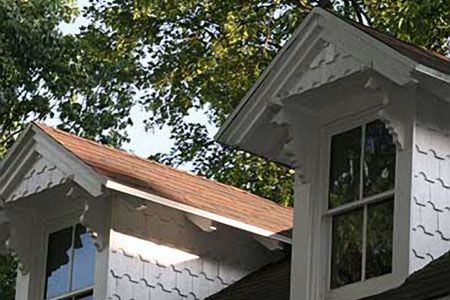A dormer is a small structure that sticks out from a sloped roof, usually containing a window. It gives more space and headroom inside, often in an attic or upper floor, and lets in light and air. Dormers come in different styles — with various window and roof options.
This article walks you through 12 different dormer roof types and which architectural styles they complement. You can also read up on how to choose a dormer window to help complete the project.
1. Arched Top
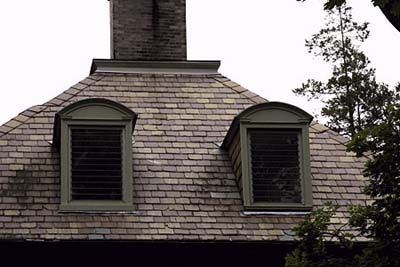
Arched top dormers are a hallmark of several French-inspired architectural styles. These elegant dormers feature a curved roof that creates interior spaces with unique ceiling shapes. These dormers often act as focal points, drawing attention to the architectural style and craftsmanship of the home.
2. Eyebrow
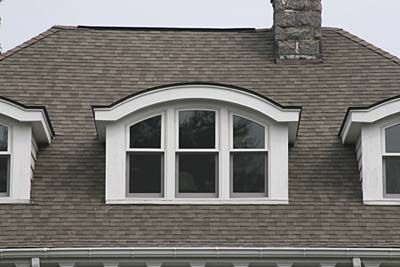
Eyebrow dormers are characterized by their distinctive curved roofs that seem to rise and fall like a gently arched eyebrow. These dormers are particularly well-suited to homes with:
- Shingle-style architecture: Popular in East Coast seashore communities
- Thatched roof-inspired designs: Where roofing shingles are curved around eaves to mimic thatch
- Tudor-style homes: Where the organic shapes complement the old-world charm
Eyebrow dormers offer a softer, more organic look than other dormer styles. They’re excellent for framing views and adding visual interest to a roofline. The interior spaces created by eyebrow dormers often have a cozy, nest-like feel.
3. Gabled
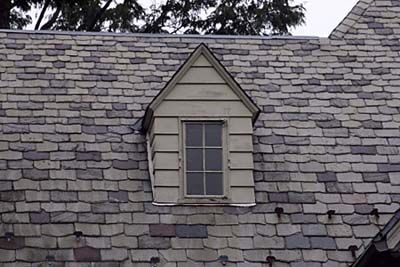
Gabled dormers are the most common dormer type, featuring a peaked roof with slopes on either side. Their versatility makes them suitable for a wide range of architectural styles, including:
- Colonial Revival
- Craftsman
- French Eclectic
- Gothic Revival
- Queen Anne Victorian
- Tudor
The simple functionality of gabled dormers makes them a popular choice for homeowners. These dormers can be designed to match the pitch and style of the main roof.
4. Flared Gable
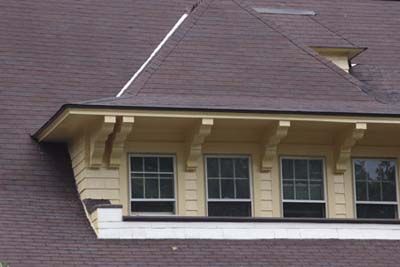
Flared gable dormers are a variation of the standard gabled dormer, featuring a roof that flares out at the bottom. This design mimics the flared eaves often seen on main roofs accommodating porches or additions.
These functional dormers provide additional shade for dormer windows and are particularly beneficial for south or west-facing dormers in hot climates. Intricate corbels often support the overhanging roof, adding another element of decorative detail. The combination of beauty and practicality makes them an appealing option for custom home designs.
5. Pedimented
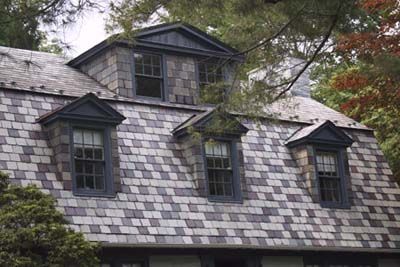
Pedimented dormers draw inspiration from classical architecture, incorporating elements reminiscent of ancient Greek and Roman buildings. These dormers feature a triangular pediment above the window, molding that emphasizes the triangular shape, and vertical molding on either side of the windows, representing columns. Pedimented dormers are particularly well-suited to the following architectural styles:
- Georgian
- Federal
- Greek Revival
Pedimented dormers can also be incorporated into more eclectic designs for a striking contrast.
6. Shed
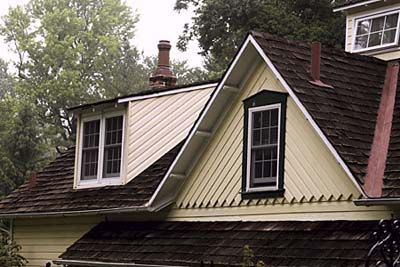
Shed dormers are characterized by their single-slope roof that angles downward from the main roof. This simple yet effective design is often found on:
- Colonial Revival architecture
- Craftsman-style houses
- Dutch Colonial homes
Shed dormers are particularly useful for adding headroom and floor space to attic areas, as their straight walls and higher ceilings maximize usable interior space. They can be designed as a single, long dormer or as multiple smaller dormers depending on the desired aesthetic and functional needs. Shed dormers are also valued for their straightforward construction and ability to blend seamlessly with various roof styles, making them a versatile choice for many homes.
7. Steep-Roof Shed
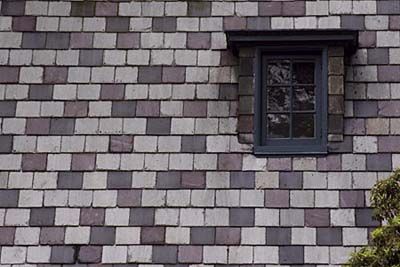
Steep-roof shed dormers are a variation of the standard shed dormer designed to fit into steeply pitched mansard roofs. These dormers sit almost flush with the surrounding roof, maintaining the distinctive silhouette of the mansard style. Mansard roofs, characterized by their dual-pitched design, create fully usable attic spaces, making dormers a natural addition.
The steep-roof shed dormer allows for larger windows, increasing natural light and ventilation. It is particularly common in Second Empire architecture and can add both functionality and visual interest to the upper floors of a home.
8. Hipped
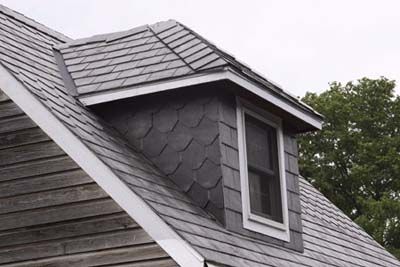
Hipped dormers feature a roof that slopes back on all three sides, including the front. This design creates a more subtle profile compared to gabled dormers, as the roof lines blend more seamlessly with the main roof. Hipped dormers are often found on homes with hipped main roofs and are particularly common in:
- French Eclectic homes
- Prairie-style architecture
- Shingle-style houses
The balanced proportions of hipped dormers make them an excellent choice for homeowners seeking a harmonious and cohesive roofline. They provide ample interior space and can accommodate various window sizes and configurations.
9. Pyramidal
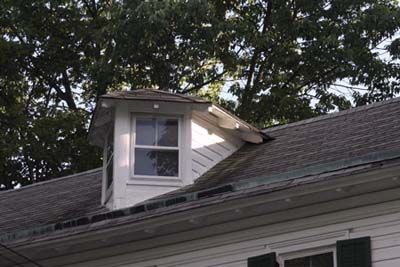
Pyramidal dormers feature a roof that rises to a point from all four sides. These dormers are typically positioned at a 45-degree angle to the main roof, creating a distinctive shape. The unusual design of pyramidal dormers allows for wrap-around views with windows on two sides.
While less common than other dormer styles, pyramidal dormers can be a standout feature on homes with more eclectic or custom designs. They’re particularly effective on corner placements or as a central focal point on a roof.
10. Recessed
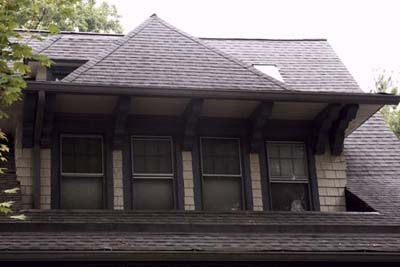
Recessed dormers, also known as inset dormers, are characterized by having one or more walls set into the roof rather than projecting outward. This unique design increases natural light and views with deeper windows.
Recessed dormers can be particularly effective in homes with steep roof pitches or in situations where local building codes restrict the height or projection of traditional dormers. They offer a modern twist on the classic dormer concept and can be adapted to various architectural styles.
11. Polygonal
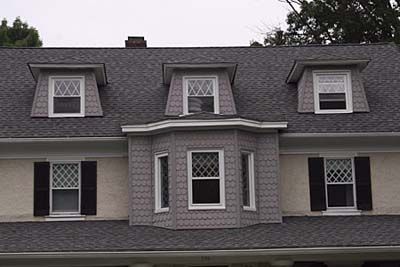
Polygonal dormers resemble a partial octagon projecting from the roof. These dormers create interesting interior spaces with angled walls and provide panoramic views from five different directions
Polygonal dormers are often used as a standout feature and can be paired with other dormer styles, such as the hip-roof dormers shown above. They are particularly well-suited to Victorian-era architecture, including Queen Anne and Stick styles, as well as contemporary home designs.
12. Wall
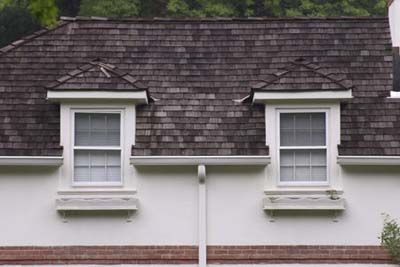
Wall dormers are unique in that they extend directly from the wall of the house rather than being surrounded by the roof. This type of dormer can incorporate various roof styles, including:
- Arched top
- Gabled roof
- Hip roof
- Shed roof
Wall dormers are versatile and can be found in a wide range of architectural styles, including Gothic Revival, Mission, and Romanesque homes.
These dormers often allow for larger windows and more interior space compared to roof-set dormers, making them an excellent choice for homeowners looking to maximize usable attic area.
